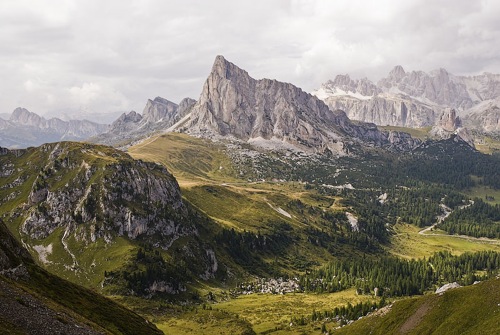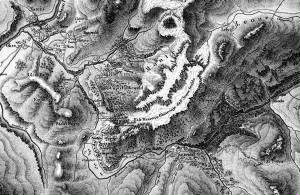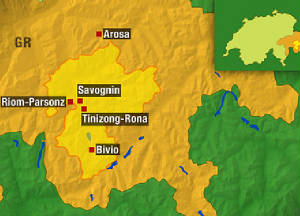|
Exploring the Alps
Arthur Young describes his journey through Savoy in 1789: "The whole day we were among the high Alps. The villages are apparently
poor, the houses ill built, and the people with few comforts about them except plenty of pine wood, the forests of which harbour
wolves and bears. Dine at Modane and sleep at St. Michel.
Pass St. Jean Maurienne. The mountains now relax their terrific features: they recede
enough to offer to the willing industry of the poor inhabitants something like a valley; but the jealous torrent seizes it
with the hand of despotism, and, like his brother tyrants, reigns but to destroy. On some slopes vines: mulberries begin to
appear; villages increase; but still continue rather shapeless heaps of inhabited stones than ranges of houses; yet in these
homely cots beneath the snowclad hills,where natural light comes with tardy beams and art seems more sedulous to exclude than
admit it, peace and content, the companions of honesty, may reside; and certainly would, were the penury of nature the only
evil felt; but the hand of despotism may be more heavy. In several places the view is picturesque and pleasing: enclosures
seem hung against the mountain sides as a picture is suspended to the wall of room.
The people are in general mortally ugly and dwarfish. Dine at La Chambre; sad fare. Sleep at Aguebelle."
Read more of Young's impressions of Savoy, click here.
Frances Trollope (writer and mother of Anthony)
observes the Tyrolean landscape, circa 1837: "The eighteen miles between this extraordinary place and Innspruck
is the very perfection of what, I suppose, all people have in their heads when they talk of Tyrolian scenery: it is not alpine
scenery, nor valley scenery, nor forest scenery, nor river scenery ; but it is a union and mixture of them all, in such a
succession of enchanting landscapes as I conceive it would be vain to look for elsewhere. I should hardly conceive it possible
for any human being to be insensible to the delight of this drive; but to any one who really loves to look upon nature the
pleasure of it is very great indeed. The general character of the whole is decidedly pastoral; for it is difficult to find
a spot where the plough has violated the softest herbage that Nature ever spread for that meek and milky tribe which here forms the husbandman's chief wealth."
Roughing it in the Dolomites,
circa 1870. Amelia
Edwards, a celebrated English novelist, traveler, and Egyptologist, described her travels to the Dolomites, at that time a
remote, difficult-to-reach place. In her preface, she notes that "the passes are too long and too fatiguing
for ladies on foot, and should not be attempted by any who cannot endure eight and sometimes ten hours of mule-riding. A small store of tea,
arrowroot, and Liebig's extract, a bottle or two of wine and brandy, a flask of spirits of wine and an Etna, are almost indispensable
adjuncts to a lengthened tour in these mountains. The basket which contains them adds but little to the impedimenta, and immensely
to the well-being of the traveller."

Retracing Wordsworth's Route Over the Simplon in 1790 As Wordsworth described it, the trail “led
at once to the bed of a stream which was to be our Companion to the Valais; and we were in the shade of a pine forest. The
stream now small, and sounding cheerfully, filled all the space at the bottom of the glen. Pine-trees cover the upright hills,
seeming to touch the sky, yet the broad highway which we had quitted, though at the first wholly out of sight, is over still
higher ground.
It was a pleasing thought, after looking in vain to espy that road, that we were enclosed among the natural solitudes
of the Alps
unmastered by the equalizing contrivances of men. ... meanwhile the voice of the stream, never turbulent, might always be
listened to. Larch trees among the pines, though less frequent than yesterday, when we had first the pleasure of seeing that
tree in its native mountain fastnesses. Some of the pines are magnificently tall.”

For more on Wordsworth's hike, click here
|
 |
|
|
|
 |
|
 |
 |
|
The Alpine Scene

Major step for Parc Ela (October 2010) Established five years ago in canton Graubuenden, Parc Ela is
the largest regional Nature Park in Switzerland, comprising 21 villages. The regional nature park designation is intended
to sustain a 'traditional cultural landscape,' while promoting sustainable tourism and other economic activity. 15 of the
21 villages must now approve the legal creation of Parc Ela. The village of Savignon was especially pivotal because a 'no'
vote there would bifurcate the proposed park area. In a recent village assembly, the majority of residents approved the
park contract, despite the opposition of village leaders. A major step forward!
Second national park for Switzerland
(August 2010) The Swiss government has granted financial aid to help in the setting up of the Adula Park straddling
the border of cantons Graubünden and Ticino, it said in a statement. Switzerland already has a national park in Graubünden,
in the Engadine, which dates from 1914. This second one would be 1,000km² in size and include the breathtaking Greina Plateau,
designated a natural monument of national importance. It would be the first national park under a new law which only
grants park status to projects that come from a regional initiative and have local community backing.
Opening the door to rural
life in Ticino (May 2010) Giovanni Buzzi, an expert on the history of rural Ticino, recounts what life must have
been like around 1850 – the start of the first wave of mass migrations overseas: "The diet was very poor and monotonous.
There was polenta [porridge-like dish made from boiled cornmeal] and bread made from rye," he says. "They had chestnuts to
see them through the winter months, and potatoes. The chestnuts were dried and either ground to make flour or cooked in water
or milk."
Wakker 2010 Heritage Prize (January 2010) Fläsch in canton Graubünden was awarded the prestigious Wakker
Heritage Prize 2010 for its “innovative local planning”. The Swiss Heritage Society awards the prize every year
to a town or village in recognition of successful urban planning developments. The village in the Rhine valley in eastern
Switzerland was singled out for its “fragmented reorganisation”, which had enabled it to maintain its winegrowing
culture in the face of housing pressure. The Swiss Heritage Society added that Fläsch’s 600 inhabitants had actively
pushed for contemporary buildings of good quality, which had successfully enforced the village’s unique character.
Playing catch-up with parks (July 2009) While Switzerland's one national park in the Engadine was established
way back in 1914, the Swiss have fallen behind other countries in creating park land. Currently 25% of Germany's land area,
for example, is protected in parks. In 2007, the Swiss environmental department outlined a process for local and regional
authorities to follow in developing new parks. The carrot: Federal subsidies. Now, almost two dozen groups (see map below)
have submitted -- or are considering -- proposals.

The website of the Network of Swiss Parks has information about a number of park proposals.
Blow to Parco Nazionale del Locarnese (May 2009) The local legislature of the Cevio municipality in
the Maggia valley has voted not to participate in efforts to establish Switzerland's second national park in the region. Ten
municipalities had previously voted in favor of the project -- unfortunately, Cevio accounts for 40% of the planned park territory.
Groups like Pro Natura hope that efforts to establish a national park in the region will continue in some fashion.

|
| Taking in the hay above Olivone |
Website of the Donetta collection
Rural Ticino as it once was (May 2009) For a glimpse of daily life in the Blenio valley in the early
20th century, visit the the Roberto Donetta collection. Donetta's wonderful images are housed in the home of the Donetta
family in Corzoneso.
Slow progress on Swiss Alpine initiative (February 2009) Fifteen years ago, the Swiss electorate voted
in a referendum to protect the Alps from the negative effects of commercial traffic. A goal was to reduce the number of heavy
truck transits across the Alps to 650,000 in 2009, almost a 50% reduction from the volume in 2000. Despite efforts to
bolster rail capacity, that goal has not been achieved. The Swiss parliament has extended the deadline to 2020, when
the Gotthard "Basistunnel" is expected to open.
Remembering the first Cook's package tour to Switzerland (November 2008)
Interviewed for a recent swissinfo article, Martino Froelicher, of Switzerland's Centre of
Transport History (ViaStoria), described how the first group of English travelers encountered a very different Alpine
scene than the one we know today. "They travelled on foot with mules and local guides because areas
like Chamonix, Sion and the Bernese Oberland were poor and had no train links or cable cars. The Swiss could not understand
why these strangers were travelling through rough mountains."
Jemima Morrell, one of the travelers, described the group's encounter with locals on the shores of
Lake Lucerne. Dozens of people were waiting for them at the pier, raucously hawking food and guide services. In the end
the police had to intervene, and later the government forbade locals from getting too close to visitors on steam boats.
But despite the odd discomfort, the visit to the "playground of Europe" was deemed a great success
and was followed up by larger package tours later in 1863 and in the following years as the venture took off. Traveling to Switzerland used to be the exclusive reserve of the rich, but Cook's package tours opened up the
country to thousands of British professionals – and later to anyone.
The new source of income revitalised the economies of struggling rural cantons and led to improvements
in infrastructure, according to Froelicher. "From that moment [1863] it became economically feasible
to construct hotels, build more railway routes and increase post carriages with better timetables," he said.
For more on the Alpine Scene, click here
|
|
 |
 |
|
 |
|
|
|